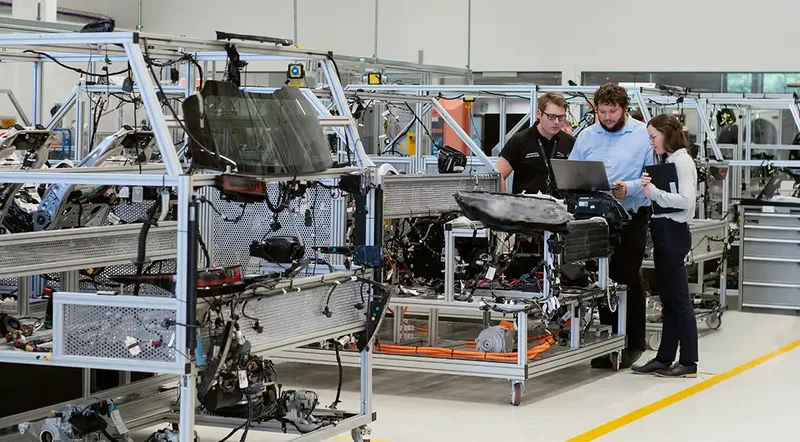

Shop Floor Management (SFM) is a technology to manage everything that happens on the factory floor and optimize production. The goal is to establish clear, safe and stable work processes to streamline daily operations and turn improvement into a natural part of the workday. SFM goes hand in hand with Lean Manufacturing and Lean Management. Both concepts aim to make production chains as efficient as possible – with zero waste whatsoever.
A supervisor’s day-to-day
Are you a production supervisor? If so, you play an essential role in ensuring that day-to-day operations go off without a hitch. In addition to managing staff planning, following up on volume objectives, reporting incidents, keeping everything in order, communicating with support functions, including maintenance, quality and production technology, not to mention all of your other responsibilities, you also need to focus on the long term and continuously improve workflows. Making improvement efforts a natural part of the workday is hard, but incredibly important for the company. With Lean and Mevisio, you get the help you need to make that happen.
What are wastes?
Within Lean, people generally talk about the following seven kinds of wastes:
- Overproduction
- Too much waiting
- Transportation waste
- Wastes in terms of processing, including instances where products are given unnecessary features without adding any value.
- Excessive inventory (or products being made)
- Movement waste (for example, if tools are placed too far away from each other)
- Waste related to the manufacturing of defective products
Additionally, not utilizing employees’ skills is seen as the eighth waste.
Use Gemba to identify wastes
There is a myriad of ways to go about identifying wastes, but the Lean toolbox offers an efficient method called Gemba walk (the correct translation from Japanese is actually Genba, but Gemba is more commonly used). The method is simple. Production managers and supervisors go around the factory floor and speak with their employees to identify wastes and opportunities for improvement. Often, this is coupled with observing Gembutsu, which is Japanese for, “A specific thing.” To further hone this method, you can also apply the quantitative analysis method of Genjitsu, which basically means basing your improvement efforts off of quantitative data. That way, your angle of approach is both qualitative and quantitative. Genchi Gembutsu is also commonly used to refer to the act of walking around the factory floor, observing and gathering facts.
Take it one step further with a digital approach
Even if physical communication is a natural part of all healthy businesses, there are many advantages from combining that communication with digital visual management, especially for production managers. Production managers are responsible for production processes and staff to ensure that the work being done is as efficient and safe as possible. And you can visualize all that in Mevisio, for example, by way of a SQCDP board. The abbreviation stands for each of the standard and recommended key performance indicators used in manufacturing industries: Safety, Quality, Cost, Delivery and People. The idea is that you drive development forward by visualizing all of the obstacles that arise in the business and adapt the work accordingly. Teams are also able to easily report incidents and suggest improvements, which can then be escalated upwards, downwards or horizontally across the organization.
Integrated data from multiple sources
Integrating Mevisio's digital boards into your existing technologies is a streamlined and user-friendly process, designed to enhance your productivity without disrupting your current operations. Our platform is built with flexibility and compatibility in mind, ensuring that it can seamlessly connect with a wide range of manufacturing and production management systems. To facilitate this integration, Mevisio offers a variety of methods, including API access and direct database connections. This versatility allows Mevisio to display real-time data from your existing systems, ensuring that the information on the digital boards is always current and accurate, making it easier to monitor performance, identify bottlenecks, and make informed decisions.
Get your employees on board
In order to get the most out of your shop floor management, you should also work to create a Lean company culture, and a large part of that responsibility falls on management. The goal is to create a positive company culture, where no one blames other people or makes a big deal out of potential problems that arise. Instead, every obstacle should be seen as an opportunity to improve. Management should take a step back and coach their employees by setting clear goals for the organization, instead of micromanaging every little thing.
Implementing SFM
Once you’ve gotten a handle on the basic principles, it’s time to start implementing SFM. Effective SFM builds on visual management, important KPIs, and the company’s status all being clearly visualized on your daily management board. That way, it’s clear to both teams and management where things stand and what needs to be prioritized. The ultimate goal is to only need one short daily huddle around the board to know exactly where things stand and what is in the works.
By visualizing production data, it also gets easier to identify and resolve potential bottlenecks and areas of improvement to eliminate waste.
How Mevisio streamlines SFM
Mevisio’s digital boards are the perfect tool to implement SFM in your business. You can think of your Gemba walks as an important way to understand what workflows look like in real life. That brings us to our next step: visualizing that information.
With Mevisio’s boards, you can clearly visualize the entire workflow, from start to finish. For example, you can visualize live and up-to-date production data, KPIs, improvement ideas and so much more on all of your devices. This leads to a greater understanding of the problems and issues that arise in the organization. Teams are also able to create and share improvement activities and 5S assessments as well as adapt their work based on the results.

.png)









